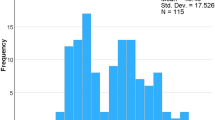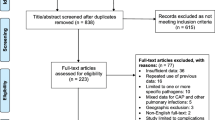Abstract
Background
Anaerobes are a relatively uncommon but important cause of bloodstream infection. However, their epidemiology has not been well defined in non-selected populations. We sought to describe the incidence of, risk factors for, and outcomes associated with anaerobic bacteremia.
Methods
Population-based surveillance for bacteremia with anaerobic microorganisms was conducted in the Calgary area (population 1.2 million) during the period from 2000 to 2008.
Results
A total of 904 incident cases were identified, for an overall population incidence of 8.7 per 100,000 per year; 231 (26 %) were nosocomial, 300 (33 %) were healthcare-associated community-onset, and 373 (41 %) were community-acquired. Elderly males were at the greatest risk. The most common pathogens identified were: Bacteroides fragilis group (3.6 per 100,000), Clostridium (non-perfringens) spp. (1.1 per 100,000), Peptostreptococcus spp. (0.9 per 100,000), and Clostridium perfringens (0.7 per 100,000). Non-susceptibility to metronidazole was 2 %, to clindamycin 17 %, and to penicillin 42 %. Relative to the general population, risk factors for anaerobic bloodstream infection included: male sex, increasing age, a prior diagnosis of cancer, chronic liver disease, heart disease, diabetes mellitus, stroke, inflammatory bowel disease, human immunodeficiency virus (HIV) infection, chronic obstructive pulmonary disease (COPD), and/or hemodialysis-dependent chronic renal failure (HDCRF). The 30-day mortality was 20 %. Increasing age, nosocomial acquisition, presence of malignancy, and several other co-morbid illnesses were independently associated with an increased risk of death.
Conclusion
Anaerobic bloodstream infection is responsible for a significant burden of disease in general populations. The data herein establish the extent to which anaerobes contribute to morbidity and subsequent mortality. This information is key in developing preventative, empiric treatment and research priorities.

Similar content being viewed by others
References
Brook I. The role of anaerobic bacteria in bacteremia. Anaerobe. 2010;16:183–9.
Goldstein EJ. Anaerobic bacteremia. Clin Infect Dis. 1996;23(Suppl 1):S97–101.
Mandell G, Bennett J, Dolin R. Mandell, Douglas, and Bennett’s principles and practice of infectious diseases. 7th ed. Philadelphia: Churchill Livingstone; 2009.
Lassmann B, Gustafson DR, Wood CM, Rosenblatt JE. Reemergence of anaerobic bacteremia. Clin Infect Dis. 2007;44:895–900.
Lombardi DP, Engleberg NC. Anaerobic bacteremia: incidence, patient characteristics, and clinical significance. Am J Med. 1992;92:53–60.
Bryan CS, Reynolds KL, Kirkhart B, Brown JJ. Bacteroides bacteremia. Analysis of 142 episodes from one metropolitan area. Arch Surg. 1984;119:894–8.
Muttaiyah S, Paviour S, Buckwell L, Roberts SA. Anaerobic bacteraemia in patients admitted to Auckland City Hospital: its clinical significance. N Z Med J. 2007;120:U2809.
Blairon L, De Gheldre Y, Delaere B, Sonet A, Bosly A, Glupczynski Y. A 62-month retrospective epidemiological survey of anaerobic bacteraemia in a university hospital. Clin Microbiol Infect. 2006;12:527–32.
Hung MN, Chen SY, Wang JL, et al. Community-acquired anaerobic bacteremia in adults: one-year experience in a medical center. J Microbiol Immunol Infect. 2005;38:436–43.
Zahar JR, Farhat H, Chachaty E, Meshaka P, Antoun S, Nitenberg G. Incidence and clinical significance of anaerobic bacteraemia in cancer patients: a 6-year retrospective study. Clin Microbiol Infect. 2005;11:724–9.
Leal J, Gregson DB, Ross T, Flemons WW, Church DL, Laupland KB. Development of a novel electronic surveillance system for monitoring of bloodstream infections. Infect Control Hosp Epidemiol. 2010;31:740–7.
Friedman ND, Kaye KS, Stout JE, et al. Health care-associated bloodstream infections in adults: a reason to change the accepted definition of community-acquired infections. Ann Intern Med. 2002;137:791–7.
Quan H, Sundararajan V, Halfon P, et al. Coding algorithms for defining comorbidities in ICD-9-CM and ICD-10 administrative data. Med Care. 2005;43:1130–9.
Clinical and Laboratory Standards Institute (CLSI). Methods for antimicrobial susceptibility testing of anaerobic bacteria; Approved standard, 7th edition. CLSI document M11-A7. Wayne: CLSI; 2007.
Clinical and Laboratory Standards Institute (CLSI). Interpretive criteria for identification of bacteria and fungi by DNA target sequencing; Approved guideline. CLSI document MM18-A, vol. 28, no. 12. Wayne: CLSI; 2008.
Calgary Health Region. Health systems analysis: demographic data. Population by Alberta regional health authorities. Available at: http://www.calgaryhealthregion.ca. Accessed 1 Aug 2010.
Renaud B, Brun-Buisson C; ICU-Bacteremia Study Group. Outcomes of primary and catheter-related bacteremia. A cohort and case–control study in critically ill patients. Am J Respir Crit Care Med. 2001;163:1584–90.
Alberta Health Services. Health system analysis: demographic data. Available at: http://www.calgaryhealthregion.ca. Accessed 1 Aug 2010.
Southern Alberta Clinic. Epidemiology of HIV. Available at: http://www.albertahealthservices.ca/6250.asp. Accessed 1 Aug 2010.
Manns BJ, Mortis GP, Taub KJ, McLaughlin K, Donaldson C, Ghali WA. The Southern Alberta Renal Program database: a prototype for patient management and research initiatives. Clin Invest Med. 2001;24:164–70.
ALTRA Southern Alberta Transplant Program. Available at: http://www.albertahealthservices.ca/services.asp?pid=service&rid=1738. Accessed 1 Aug 2010.
Health Canada. Statistical report on the health of Canadians. Available at: http://www.statcan.gc.ca/pub/82-570-x/4064413-eng.htm. Accessed 01 Aug 2010.
Alberta Diabetes Surveillance System. Available at: http://www.albertadiabetes.ca. Accessed 1 Aug 2010.
Bernstein CN, Wajda A, Svenson LW, et al. The epidemiology of inflammatory bowel disease in Canada: a population-based study. Am J Gastroenterol. 2006;101:1559–68.
Marrett LD, De P, Airia P, Dryer D; Steering Committee of Canadian Cancer Statistics 2008. Cancer in Canada in 2008. CMAJ. 2008;179:1163–70.
Gabriel SE, Crowson CS, O’Fallon WM. The epidemiology of rheumatoid arthritis in Rochester, Minnesota, 1955–1985. Arthritis Rheum. 1999;42:415–20.
Papaparaskevas J, Katsandri A, Pantazatou A, et al. Epidemiological characteristics of infections caused by Bacteroides, Prevotella and Fusobacterium species: a prospective observational study. Anaerobe. 2011;17:113–7.
Salonen JH, Eerola E, Meurman O. Clinical significance and outcome of anaerobic bacteremia. Clin Infect Dis. 1998;26:1413–7.
Laupland KB. Population-based epidemiology of intensive care: critical importance of ascertainment of residency status. Crit Care. 2004;8:R431–6.
Paltiel O, Ronen I, Polliack A, Epstein L. Two-way referral bias: evidence from a clinical audit of lymphoma in a teaching hospital. J Clin Epidemiol. 1998;51:93–8.
Smith LD. Virulence factors of Clostridium perfringens. Rev Infect Dis. 1979;1:254–62.
McClane B. Clostridium perfringens type C isolates rapidly upregulate their toxin production upon contact with host cells: new insights into virulence? Virulence. 2010;1:97–100.
Robert R, Deraignac A, Le Moal G, Ragot S, Grollier G. Prognostic factors and impact of antibiotherapy in 117 cases of anaerobic bacteraemia. Eur J Clin Microbiol Infect Dis. 2008;27:671–8.
Nguyen MH, Yu VL, Morris AJ, et al. Antimicrobial resistance and clinical outcome of Bacteroides bacteremia: findings of a multicenter prospective observational trial. Clin Infect Dis. 2000;30:870–6.
Aldridge KE, Ashcraft D, O’Brien M, Sanders CV. Bacteremia due to Bacteroides fragilis group: distribution of species, beta-lactamase production, and antimicrobial susceptibility patterns. Antimicrob Agents Chemother. 2003;47:148–53.
Snydman DR, Jacobus NV, McDermott LA, et al. Lessons learned from the anaerobe survey: historical perspective and review of the most recent data (2005–2007). Clin Infect Dis. 2010;50(Suppl 1):S26–33.
Hecht DW. Anaerobes: antibiotic resistance, clinical significance, and the role of susceptibility testing. Anaerobe. 2006;12:115–21.
Davies HD, McGeer A, Schwartz B, et al. Invasive group A streptococcal infections in Ontario, Canada. Ontario Group A Streptococcal Study Group. N Engl J Med. 1996;335:547–54.
Farley MM, Harvey RC, Stull T, et al. A population-based assessment of invasive disease due to group B Streptococcus in nonpregnant adults. N Engl J Med. 1993;328:1807–11.
Conflict of interest
No external financial support was obtained for this study. None of the authors had any financial, professional, or personal competing interests that would influence the conduct or reporting of this study.
Author information
Authors and Affiliations
Corresponding author
Rights and permissions
About this article
Cite this article
Ngo, J.T., Parkins, M.D., Gregson, D.B. et al. Population-based assessment of the incidence, risk factors, and outcomes of anaerobic bloodstream infections. Infection 41, 41–48 (2013). https://doi.org/10.1007/s15010-012-0389-4
Received:
Accepted:
Published:
Issue Date:
DOI: https://doi.org/10.1007/s15010-012-0389-4




